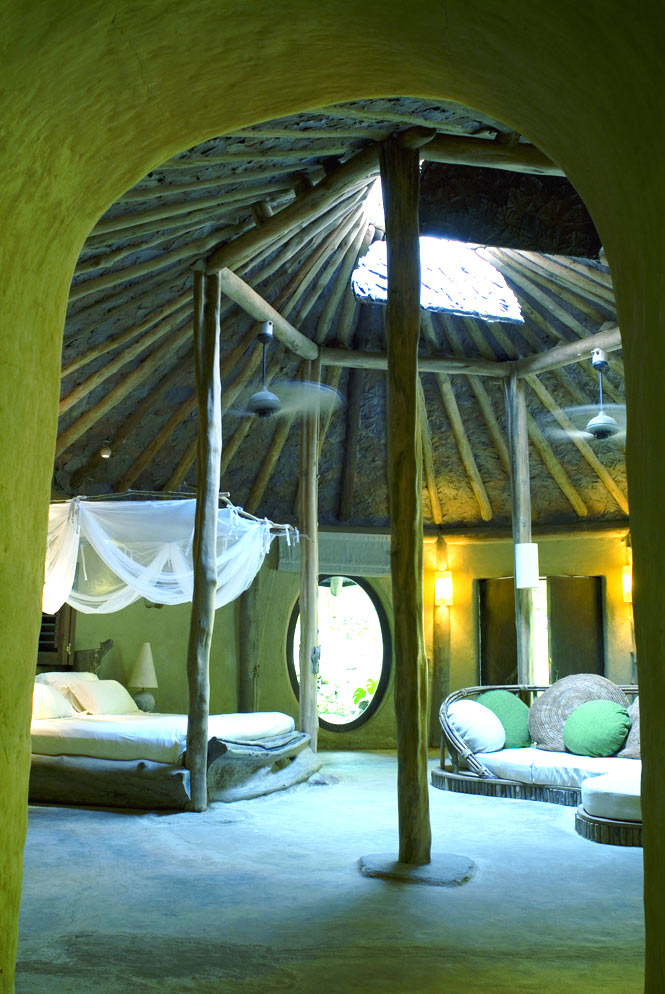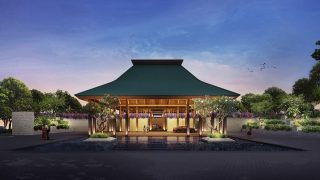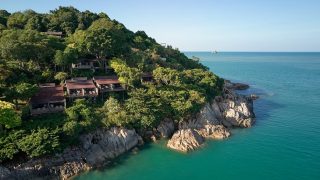Above: Soneva Kiri’s Eco Villa blends almost seamlessly with its environment.
A villa in Thailand sets a new benchmark for eco-friendly resort design.
By Leisa Tyler
Photographs by Leisa Tyler
It may appear like something out of The Flintstones, but the new Eco Villa at Six Senses’ Soneva Kiri resort is anything but prehistoric. Set in its own jungle clearing on the island of Koh Kood, not far from where Thailand’s eastern seaboard rubs up against Cambodia, this deceivingly rustic-looking amalgam of natural materials and environmentally sound engineering might just represent the future of sustainable luxury.
The villa’s exterior is a patchwork of stones held in place with buffalo-skin glue and jaggery. The roof sprouts native grass and ferns, among which birds have nested. Inside, mud-brick walls plastered with a mix of clay and rice husk radiate a warm glow. Look up, and you’ll find that the ceiling is lined with teak leaves; logs of casuarina driftwood serve as rafters.
Since its inception in 1995, Bangkok-based Six Senses Resorts & Spas has built a reputation for its commitment to the environment. Still, the Eco Villa at Soneva Kiri takes this dedication to a new level. Louis Thompson, the group’s “director of green building,” designed the structure, basing it on the naturally ventilated Miwok tepees of northern California. “The idea,” he says, “was to create a house with a strong connection to the earth.” The result is a surprisingly stylish, carbon-free suite—a prototype residence that Thompson hopes will form the basis of Six Senses’ forthcoming zero-emissions resort brand, Evaluations.
Thompson recruited a team of Thai craftsmen to fashion the villa and its furnishings, and sought out cutting-edge environmental technologies to ensure guest comfort was not compromised. Solar panels and a wind turbine may be the Eco Villa’s sole sources of energy, but that’s sufficient to heat water for the outdoor shower, run an air conditioner and a Phillips Eco TV, and power an electric buggy. Meter-thick walls and a cellulose-insulated roof keep the interiors naturally cool, while the chemical-free swimming pool is filled with rainwater filtered through surrounding reed beds. Other innovative touches include a domed mud-brick wine cellar, used during construction as a kiln for baking terra-cotta pipes and downspouts.
“Using green-building principals,” Thompson says, “we’ve tried to achieve the same level of comfort here as in a normal Six Senses villa.” Such comfort doesn’t come cheap: a night in the Eco Villa costs US$1,192, and that’s in the low season. Still, for travelers who are passionate about minimizing their ecological footprint, that seems a small price to pay (66-3/961-9800; sixsenses.com).
Originally appeared in the April/May 2010 print issue of DestinAsian magazine (“Second Nature”)









